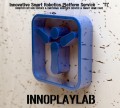Korean super dog latest entry into social robot market
15 August 2016 | By David Rogers1 Comment
South Korean technology start-up Innoplaylab is planning to join the burgeoning market for “companion” robots with a silicon pet that combines the roles of guard dog, nanny, computer, smartphone and remote controller.
The Domgy (“my dog”) unit is intended to capitalise on developments in the fields of artificial intelligence (AI), speech-recognition and autonomous driving technology and combine them with the growing market for smart home appliances and emotionally intelligent robots.
Jean Jeon, a director of Innoplaylab, told GCR that the unit had the functionality of Amazon’s Echo speaker, to which it added a range of extra abilities. He said: “It has visual and infrared sensors, it can talk and listen, it can access the internet using Wi-Fi or 4G networks, it can move around a house without bumping into things, and it will navigate to its charging dock when its battery runs down.”
“It will build up profiles of people it meets regularly, it will be able to recognise their faces and voices, and it will talk to a teenager in a different way to an adult.”– Jean Jeon, director of Innoplaylab
The sensors and the mobility enable Domgy to look after an empty house. If it detects something untoward, it can call the owner and send them a picture of what it’s looking at. It can use its infrared sensor and the Bluetooth protocol to control appliances such as televisions and air-conditioning units, and could turn off ovens and irons that have been left on by mistake.
Jeon said it will be able to carry out smart interactions with people as well as appliances.
He said: “It will build up profiles of people it meets regularly, it will be able to recognise their faces and voices, and it will talk to a teenager in a different way to an adult. It can monitor the health of the elderly, prompt them to take medication. Equally, it can read bedtime stories to children using its text-to-speech function, play music and dance to it, send emails using its speech-to-text and remember its owners’ birthdays.



